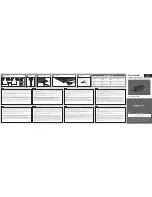
2-62
Service Guide
The display system can independently place either RGB or YUV data from anywhere in display
memory into an on-screen window which can be any size and located at any pixel boundary (YW
data is converted to RGB "on-the-fly" on output). Non-rectangular windows are supported via color
keying. The data can be fractionally zoomed on output up to 8x to fit the onscreen window and can
be horizontally and vertically interpolated. Interlaced and non-interlaced data are supported in both
capture and display systems.
2.4.3.5 Video Acceleration
When the system writes to the video YW memory, the 65555 uses its PCI Bust Mode capabilities
to allow for a higher frame rate. Video capture input through the ZV port is scaled and stored into
memory allowing frame capture for video conferencing. In addition, the 65555 will use vertical
interpolation of video data up to 720 pixels wide to enable smooth zooming to full screen MPEG II
video. Double buffering is used to prevent image tearing.
2.4.3.6 Versatile Panel Support
The HiQVideo family supports a wide variety of monochrome and color Single-Panel, Single-Drive
(SS) and Dual-Panel, Dual Drive (DD) standard and high-resolution passive STN and acfive matrix
TFT/MIM LCD, and EL panels. For monochrome panels, up to 64 gray scales are supported. With
the help of HiQColor Technology, STN panels can afford 256 gray shades per primary resulting in
16M colors for an improved image representation. Additionally, the HiQVPro also supports TFT
panels up to 36-bit interface. The HiQVideo family offers a variety of programmable features to
optimize display quality. Vertical centering and stretching are provided for handling modes with
less than 480 lines on 480line panels. Horizontal and vertical stretching capabilities are also
available for both text and graphics modes for optimal display of VGA text and graphics modes on
800x600 and 1024x768 panels. Three selectable color-to-gray scale reduction techniques and
SMARTMAP are available for improving the ability to view color applications on monochrome
panels.
2.4.3.7 Low Power Consumption
The HiQVideo family uses a variety of advanced power management features to reduce power
consumption of the display sub-system and to extend battery life. Although optimized for 3.3V
operation, the HiQVideo controller's internal logic, memory interface, bus interface, and panel
interfaces can be independently configured to operate at either 3.3V or 5V.
2.4.3.8 Software Compatibility/Flexibility
The HiQVideo controllers are fully compatible with VGA at the register, and BIOS levels. CHIPS
and third-party vendors supply fully VGA-compatible BIOS, end-user utilities and drivers for
common application programs such as Microsoft Windows and OS/2.
The 65555 BIOS and drivers are an evolutionary step from the 65554 software. The Windows
drivers provided for the 65555 are compliant with both Microsoft WHQL and PC97 standards.
2.4.3.9 Display Memory Size Requirements
The 65555 supports the following 32-bit wide and 64-bit wide memory configuration show below:
Summary of Contents for 390 Series
Page 15: ...System Introduction 1 3 Figure 1 2 PCB No 96183 1A Mainboard Layout Bottom ...
Page 96: ...2 50 Service Guide 2 3 3 Pin Configuration Figure 2 4 FDC37C67 TQFP Pin Diagram ...
Page 97: ...Major Chips Description 2 51 Figure 2 5 FDC37C67 QFP Pin Diagram ...
Page 102: ...2 56 Service Guide 2 3 6 Block Diagram Figure 2 6 FDC37C67 Block Diagram ...
Page 126: ...2 80 Service Guide 2 5 4 1 Functional Block Diagram Figure 2 10 M38813 Block Diagram ...
Page 128: ...2 82 Service Guide 2 6 2 Pin Diagram Figure 2 11 YMF715 Block Diagram ...
Page 168: ......
Page 169: ......
Page 170: ......
Page 171: ......
Page 172: ......
Page 173: ......
















































